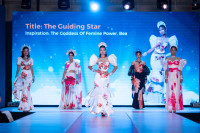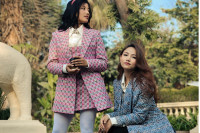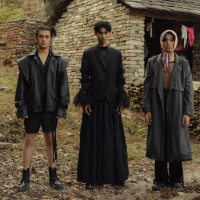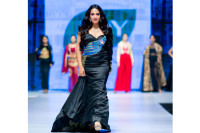Fashion
Fashion with intent
Sangram, a clothing brand has varied and diverse collections. However, the mood of their photographs is usually consistent.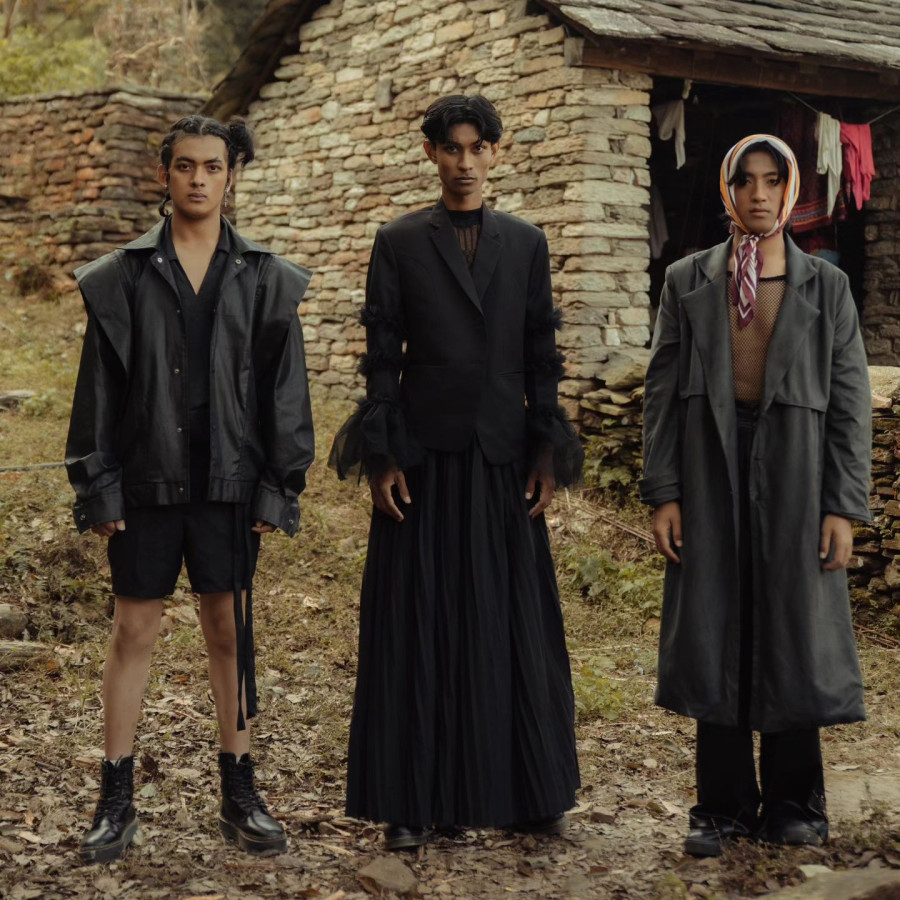
Anusha Dhakal
The Nepali fashion market is currently flooded with fast fashion imports and dominated by wear-and-throw clothing. In this somewhat bleak scene, Sangram, a fashion brand with its atelier located in Maharjgunj, stands out by offering a refreshing change to the Nepali fashion scene with its beautifully designed elevated basics that are sustainably made and impeccably tailored.
The brand’s collections, vision, and creative direction set it apart. Its memorability is enhanced by its intuitive, artistic photoshoots, where models stand straight and stare intensely into the camera, reminiscent of Marcelo Gaia’s New York-based brand Mirror Palais.
Unlike Mirror Palais’s dreamy fashion shoots, which feature ivory backgrounds and fairytale-like clothing, Sangram takes a melancholic approach. The photographs adopt a dark hue, and the models display grim expressions.
In one of its shoots titled ‘Incoherency’, photographed by Mirage Gurung, the brand offers viewers a visual feast. The photos feature three models, with the central figure adorned in an extravagant, voluminous neon orange dress and a large, ruffled mask.
The interplay of the models’ gazes, or lack thereof, creates stunning visual poetry. The brand’s collections are varied and diverse, but the mood of the photographs is usually consistent, representing Sangram as a brand visually.
The brand has also ventured into filmmaking to showcase its collections. In the short film ‘Ghar’, clothing is showcased ingeniously, despite its promotional intent.
It is refreshing to see how meaning, intention, and artistry are woven into Sangram’s brand identity through its elaborate photoshoots and dedicated films in the Nepali fashion scene.
Sandesh Sangram Rai, 28, the founder and creative director of the brand, launched it during the Covid-19 pandemic. Previously an anthropology student, he brings more than just fashion to the table. This is evident through the brand's recently ended exhibition, which offered a unique wearable experience featuring capsule wardrobes and designs inspired by concurrent art pieces.
The exhibition was immersive and intuitive, engaging both individual and collective consciousness. It explored themes like mental health and femininity while also addressing fashion waste. This was achieved not just by acknowledging the existence of fashion waste, but by ensuring minimal waste and sustainability practices in the exhibition itself.
Rai, the founder, explained why he chose Khapinchhen Tole for the exhibition instead of other art museums or clubs. Influenced by the Kirat Kipat system, where communities unite for common goals without hidden agendas, the exhibition embodies this spirit of collective effort and altruism.
Local women served Newari food throughout the exhibition, and community members supported its construction. Rai added, “Khapinchhen is deeply rooted and welcoming, and to receive permission to create art in such a historic and beautiful space was truly special for us.”
The exhibition featured capsule collections based on artworks by Mina Garbuja, Suruchi BK, Suza Magar, Yanjan Kumar Joshi, and Sandesh Sangram Rai.
Garbuja’s collection was centred around the art piece ‘Tied Up Femininity’, featuring traditional laccha dori. These laccha dori contain notes written by women sharing stories of the challenges faced while growing up as girls.
Visitors were encouraged to add their own notes, reflecting on their journey from girlhood to adulthood or sharing personal stories, including experiences of sexual abuse if they wish, and hang them on the laccha dori.
According to Garbuja, her clothing collection, inspired by the art piece, focused on clean lines, subtle details, and minimal, toned-down colours. She incorporates pleats, draping, and straps as the primary design elements in women’s clothing, referencing the concept of dori or laccha dori in her capsule collection.
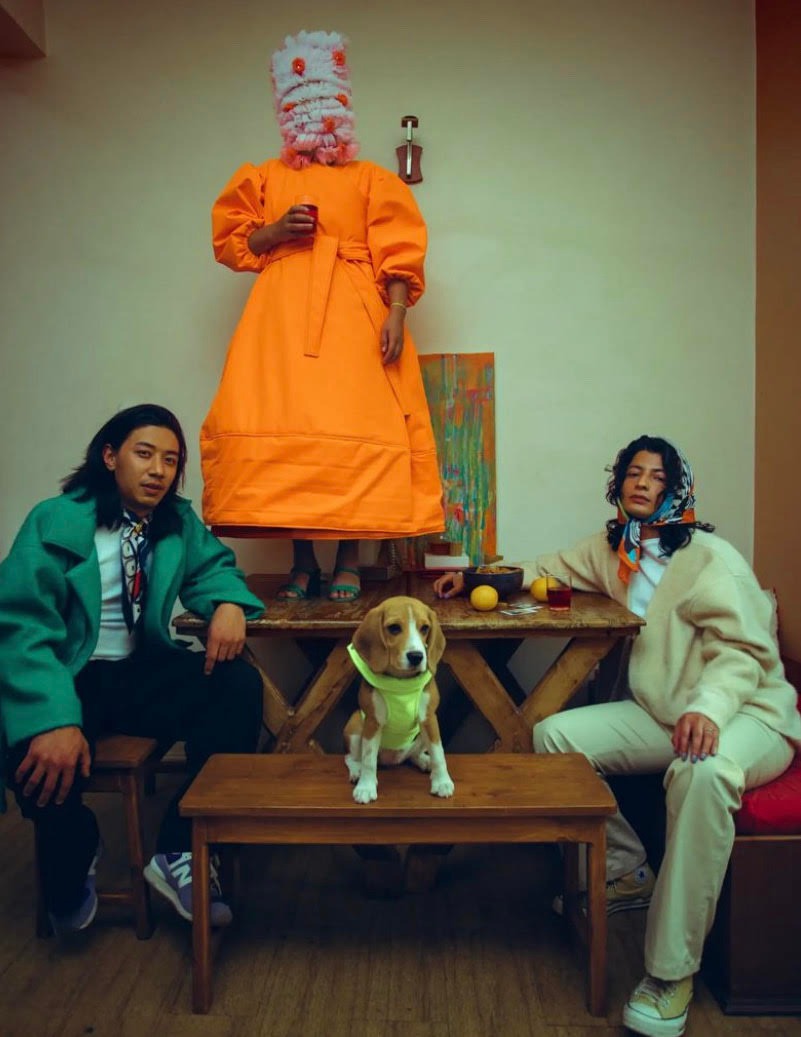
Suza Magar’s collection was inspired by an art piece titled ‘Nightmare and Paranoia’. This piece features a stark, cold bunk bed adorned with red yarn. This immersive installation invites visitors to sleep on the bed and experience the discomfort of having yarn near their faces, recreating the unsettling feeling associated with nightmares.
Magar’s collection embraced this theme by incorporating textured fabrics, nets, pleats, and prints designed to evoke feelings of unease and vulnerability in the wearer.
Yanjan Kumar Joshi’s capsule collection was inspired by an art piece, but he interprets it differently from what initially meets the eye. According to him, “This installation represents the artist's mind as a chaotic mess, but also as a comforting meadow where inspiration and joy are found.”
His collection features reused buttons as appliqués, minimal fabric wastage, and versatile, unisex designs.
Sandesh Sangram Rai adds that the scrap fabrics will be reused and upcycled to create other materials. He further explains that salvaged and previously unused muslin fabric will also be repurposed.
Rai underscores that all materials used in the exhibition will focus on reuse or upcycling, highlighting the brand’s commitment to sustainability and minimal waste.
Another captivating art piece, titled ‘Wrapped up in my Ama’s Saree’, showcases numerous sarees suspended from the ceiling, forming an elaborate and visually engaging installation. This piece explores the notion that societal norms can restrain individuals, with the sarees symbolising the burdens imposed by societal ills.
Suruchi BK’s collection drew inspiration from this art piece. In her designs, she creatively utilises upcycled sarees to craft innovative pieces. This approach not only breathes new life into unused sarees but also addresses the issue of waste in fashion.
The exhibition was divided into two floors: one showcasing the art pieces alongside the clothing collections, while the top floor featured a changing room and items from Sangram’s previous collections.
This setup aptly earned the exhibition its title as a ‘wearable exhibition’, allowing visitors to select clothes they like, try them on, and experience the garments as art pieces themselves. This approach underscores their innovative integration of clothing displays and art exhibitions.
Like previous photography and filmmaking campaigns, the exhibition integrated various art forms into fashion, imbuing it with deeper significance. It adopted a runway approach without the traditional runway setting by allowing each garment to convey a meaningful story accompanied by art installations.
The clothes presented in the exhibition are available for purchase.




 18.35°C Kathmandu
18.35°C Kathmandu
